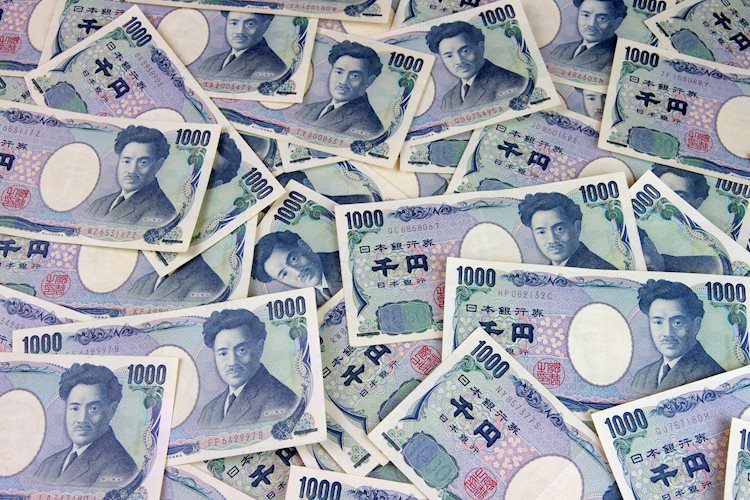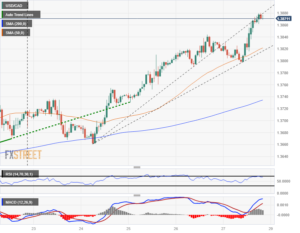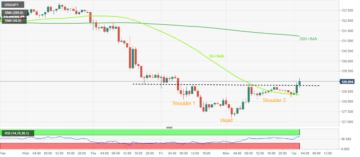
- The Japanese Yen continues to draw support from hawkish BoJ expectations.
- A softer risk tone further seems to benefit the JPY’s relative safe-haven status.
- Fed rate cut bets drag the USD closer to the monthly low and weigh on USD/JPY.
The Japanese Yen (JPY) strengthens against the US Dollar (USD) for the third successive day on Tuesday and is supported by the increasing likelihood of a policy shift by the Bank of Japan (BoJ). The incoming inflation data from Japan suggests that the economy is making progress towards achieving sustained rises in inflation, which should allow the BoJ to consider normalising its ultra-loose monetary policy.
This, along with a generally weaker tone around the equity markets, continues to underpin the safe-haven JPY. Apart from this, the prevalent USD selling bias, fuelled by increased chances of earlier rate cuts by the Federal Reserve (Fed) in 2024, drags the USD/JPY pair to the 148.00 neighbourhood, or a four-day low during the Asian session and ahead of speeches by a slew of FOMC members later today.
Daily Digest Market Movers: Japanese Yen remains supported by stronger domestic inflation data
Government data showed on Friday that the nationwide headline and core CPI remained above the Bank of Japan’s 2% target for the 19th consecutive month in October.
Furthermore, a surge in Japan’s wholesale services inflation, driven by a tight job market, fuels speculations that the BoJ will end its negative interest rate policy in 2024.
The services Producer Price Index (PPI) released on Monday accelerated to 2.3% in October from a year earlier from a revised 2.0% rise in the previous month.
Japan’s big employers are set to follow this year’s bumper pay hikes in 2024, giving the Japanese central bank additional room to finally roll back massive monetary stimulus.
The US Dollar drops back closer to the monthly low amid growing acceptance that the Federal Reserve is done raising rates and may begin easing policy as early as March 2024.
A softer risk tone benefits the JPY’s safe-haven status and contributes to the offered tone surrounding the USD/JPY pair for the third successive day on Tuesday.
Investors now look forward to the release of the BoJ Core CPI report for short-term impetus.
The BoJ’s preferred inflation gauge, which has been steadily rising from a 2023 low of 2.7% in February, is expected to hold steady at the 3.4% YoY rate in October.
Amid speeches by a slew of influential FOMC members, the Conference Board’s US Consumer Confidence Index might also contribute to producing short-term trading opportunities later during the North American session.
Technical Analysis: USD/JPY bears could target 100-day SMA support, just below the 147.00 mark
From a technical perspective, a sustained break and acceptance below the 148.00 round figure will expose the 100-day Simple Moving Average (SMA), currently near the 147.90-147.85 zone, which if broken decisively will be seen as a fresh trigger for bearish traders and pave the way for deeper losses towards the monthly low, around the 147.15 area.. The USD/JPY pair might then accelerate the fall towards the 146.00 mark en route to the next relevant support near the 145.50 zone.
On the flip side, immediate resistance is pegged near the 148.80 region ahead of the 149.00 mark and the weekly peak, around the 149.65 region touched on Monday. A sustained strength beyond could lift the USD/JPY pair beyond the 150.00 psychological mark, towards the 150.35 resistance zone. Some follow-through buying will negate any near-term negative bias and allow bulls to reclaim the 151.00 round-figure mark.
Japanese Yen price today
The table below shows the percentage change of Japanese Yen (JPY) against listed major currencies today. Japanese Yen was the strongest against the US Dollar.
| USD | EUR | GBP | CAD | AUD | JPY | NZD | CHF | |
| USD | 0.01% | 0.00% | 0.00% | -0.03% | -0.14% | -0.04% | -0.03% | |
| EUR | -0.02% | 0.00% | -0.02% | -0.05% | -0.14% | -0.06% | -0.04% | |
| GBP | 0.00% | 0.01% | 0.00% | -0.03% | -0.13% | -0.03% | -0.01% | |
| CAD | -0.01% | -0.01% | -0.02% | -0.05% | -0.14% | -0.05% | -0.03% | |
| AUD | 0.02% | 0.01% | 0.02% | 0.02% | -0.10% | -0.02% | 0.02% | |
| JPY | 0.15% | 0.12% | 0.13% | 0.14% | 0.08% | 0.06% | 0.13% | |
| NZD | 0.05% | 0.06% | 0.04% | 0.03% | 0.01% | -0.10% | 0.04% | |
| CHF | 0.03% | 0.03% | 0.02% | 0.02% | -0.01% | -0.13% | -0.04% |
The heat map shows percentage changes of major currencies against each other. The base currency is picked from the left column, while the quote currency is picked from the top row. For example, if you pick the Euro from the left column and move along the horizontal line to the Japanese Yen, the percentage change displayed in the box will represent EUR (base)/JPY (quote).
Bank of Japan FAQs
The Bank of Japan (BoJ) is the Japanese central bank, which sets monetary policy in the country. Its mandate is to issue banknotes and carry out currency and monetary control to ensure price stability, which means an inflation target of around 2%.
The Bank of Japan has embarked in an ultra-loose monetary policy since 2013 in order to stimulate the economy and fuel inflation amid a low-inflationary environment. The bank’s policy is based on Quantitative and Qualitative Easing (QQE), or printing notes to buy assets such as government or corporate bonds to provide liquidity. In 2016, the bank doubled down on its strategy and further loosened policy by first introducing negative interest rates and then directly controlling the yield of its 10-year government bonds.
The Bank’s massive stimulus has caused the Yen to depreciate against its main currency peers. This process has exacerbated more recently due to an increasing policy divergence between the Bank of Japan and other main central banks, which have opted to increase interest rates sharply to fight decades-high levels of inflation. The BoJ’s policy of holding down rates has led to a widening differential with other currencies, dragging down the value of the Yen.
A weaker Yen and the spike in global energy prices have led to an increase in Japanese inflation, which has exceeded the BoJ’s 2% target. Still, the Bank judges that the sustainable and stable achievement of the 2% target has not yet come in sight, so any sudden change in the current policy looks unlikely.
- SEO Powered Content & PR Distribution. Get Amplified Today.
- PlatoData.Network Vertical Generative Ai. Empower Yourself. Access Here.
- PlatoAiStream. Web3 Intelligence. Knowledge Amplified. Access Here.
- PlatoESG. Carbon, CleanTech, Energy, Environment, Solar, Waste Management. Access Here.
- PlatoHealth. Biotech and Clinical Trials Intelligence. Access Here.
- Source: https://www.fxstreet.com/news/japanese-yen-strengthens-further-against-usd-amid-divergent-boj-fed-policy-expectations-202311280211
- :has
- :is
- :not
- 1
- 15%
- 150
- 2%
- 2013
- 2016
- 2023
- 2024
- 31
- 32
- 33
- 35%
- 39
- 41
- 50
- 65
- 80
- a
- above
- accelerate
- accelerated
- acceptance
- achievement
- achieving
- Additional
- against
- ahead
- allow
- along
- also
- American
- Amid
- an
- analysis
- and
- Animate
- any
- apart
- ARE
- AREA
- around
- AS
- asian
- Assets
- At
- average
- back
- Bank
- bank of japan
- Bank of Japan (BoJ)
- Banknotes
- Banks
- base
- based
- BE
- bearish
- Bears
- been
- begin
- below
- benefit
- benefits
- Bets
- between
- Beyond
- bias
- Big
- board
- boj
- BOJ Core CPI
- Bonds
- Box
- Break
- Broken
- Bulls
- buy
- Buying
- by
- carry
- caused
- central
- Central Bank
- Central Banks
- chances
- change
- Changes
- closer
- Column
- come
- Conference
- conference board
- confidence
- Confidence Index
- consecutive
- Consider
- consumer
- content
- continues
- contribute
- contributes
- control
- controlling
- Core
- Corporate
- could
- country
- CPI
- currencies
- Currency
- Current
- Currently
- Cut
- cuts
- data
- day
- deeper
- depreciate
- Digest
- directly
- displayed
- Divergence
- Dollar
- Domestic
- done
- doubled
- down
- draw
- driven
- Drops
- due
- during
- each
- Earlier
- Early
- easing
- economy
- embarked
- employers
- end
- ends
- energy
- energy prices
- ensure
- Environment
- equity
- Equity Markets
- EUR
- Euro
- example
- exceeded
- expanded
- expectations
- expected
- Fall
- FAQ
- February
- Fed
- Federal
- federal reserve
- fight
- Figure
- Finally
- First
- Flip
- follow
- FOMC
- For
- Forward
- fresh
- Friday
- from
- Fuel
- fuels
- further
- gauge
- generally
- Giving
- Global
- Government
- government bonds
- Growing
- Have
- Hawkish
- headline
- Hikes
- hold
- holding
- Horizontal
- HTTPS
- if
- immediate
- in
- Incoming
- Increase
- increased
- increasing
- index
- inflation
- Influential
- interest
- INTEREST RATE
- Interest Rates
- introducing
- issue
- ITS
- Japan
- Japanese
- Japanese inflation
- Japanese Yen
- Job
- jpg
- JPY
- judges
- just
- later
- Led
- left
- levels
- likelihood
- Line
- Liquidity
- Listed
- Look
- LOOKS
- losses
- Low
- Main
- major
- Making
- mandate
- map
- March
- March 2024
- mark
- Market
- Markets
- massive
- May..
- means
- Members
- might
- module
- Monday
- Monetary
- Monetary Policy
- Month
- monthly
- more
- move
- Movers
- moving
- moving average
- Nationwide
- Near
- negative
- negative interest rates
- next
- North
- Notes
- now
- october
- of
- offered
- on
- opportunities
- or
- order
- Other
- out
- pair
- pave
- Pay
- Peak
- peers
- pegged
- percentage
- perspective
- pick
- picked
- plato
- Plato Data Intelligence
- PlatoData
- policy
- ppi
- preferred
- prevalent
- previous
- price
- Prices
- printing
- process
- producing
- Progress
- provide
- psychological
- qualitative
- quantitative
- quote
- raising
- Rate
- Rates
- recently
- region
- relative
- release
- released
- relevant
- remained
- remains
- report
- represent
- Reserve
- Resistance
- Rise
- Rises
- rising
- Risk
- Roll
- Room
- round
- Route
- ROW
- s
- seems
- seen
- Selling
- Services
- session
- set
- Sets
- shift
- short-term
- should
- showed
- Shows
- side
- Sight
- Simple
- since
- SMA
- So
- some
- speeches
- spike
- Stability
- stable
- starts
- Status
- steadily
- steady
- Still
- stimulate
- stimulus
- Strategy
- strength
- Strengthens
- stronger
- strongest
- such
- sudden
- Suggests
- support
- Supported
- surge
- Surrounding
- sustainable
- sustained
- table
- Target
- Technical
- that
- The
- The Weekly
- then
- Third
- this
- this year
- to
- today
- TONE
- top
- touched
- towards
- Traders
- Trading
- trigger
- Tuesday
- underpin
- unlikely
- us
- US Dollar
- USD
- USD/JPY
- value
- was
- Way..
- weekly
- weigh
- which
- while
- wholesale
- will
- with
- year
- Yen
- yet
- Yield
- you
- zephyrnet











